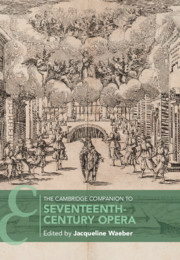Book contents
- The Cambridge Companion to Seventeenth-Century Opera
- Cambridge Companions to Music
- The Cambridge Companion to Seventeenth-Century Opera
- Copyright page
- Contents
- Music Examples
- Figures
- Tables
- Contributors
- Preface
- Chronology
- Abbreviations
- Part I The Italian Foundations
- Part II Society, Institutions, and Production
- Part III National Traditions (outside Italy)
- 10 Opera in France c. 1640–c. 1710
- 11 Song and Declamation in French Opera
- 12 Opera in England
- 13 The Development of Opera in the German Countries
- 14 Opera in Spain and the Spanish Dominions in Italy and the Americas
- Further Reading
- Index
14 - Opera in Spain and the Spanish Dominions in Italy and the Americas
from Part III - National Traditions (outside Italy)
Published online by Cambridge University Press: 08 December 2022
- The Cambridge Companion to Seventeenth-Century Opera
- Cambridge Companions to Music
- The Cambridge Companion to Seventeenth-Century Opera
- Copyright page
- Contents
- Music Examples
- Figures
- Tables
- Contributors
- Preface
- Chronology
- Abbreviations
- Part I The Italian Foundations
- Part II Society, Institutions, and Production
- Part III National Traditions (outside Italy)
- 10 Opera in France c. 1640–c. 1710
- 11 Song and Declamation in French Opera
- 12 Opera in England
- 13 The Development of Opera in the German Countries
- 14 Opera in Spain and the Spanish Dominions in Italy and the Americas
- Further Reading
- Index
Summary
Opera was produced only rarely in the otherwise vibrant theatrical culture of seventeenth-century Spain and her American dominions, though Italian operas and occasional Spanish ones became a mainstay of public life in the Spanish-held territories in Italy, especially Naples and Milan. At the royal court in Madrid and the principal administrative centres of the overseas colonies (Lima and Mexico), opera was inextricably bound to dynastic politics and constrained by conventions about the gender of onstage singers. Several other kinds of plays with music were produced at theatres both public and private, however, and commercial theatres known as corrales were among the busiest sites of musical performance and cultural transmission. Some 10,000 plays were performed in Madrid in the course of the seventeenth century, although only about 2,000 such texts have been preserved. The principal theatrical genre was the comedia nueva, a three-act play in poly-metric verse in which the tragic and the comic were mingled to recreate the natural balance of human existence with varying degrees of verisimilitude.
- Type
- Chapter
- Information
- The Cambridge Companion to Seventeenth-Century Opera , pp. 312 - 342Publisher: Cambridge University PressPrint publication year: 2022

